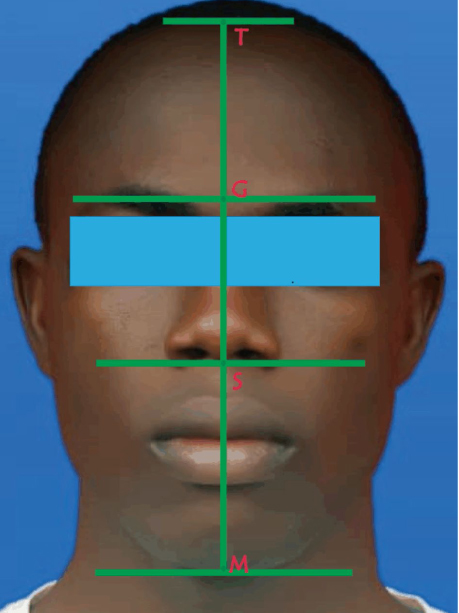Anat Biol Anthropol.
2019 Dec;32(4):115-119. 10.11637/aba.2019.32.4.115.
Horizontal Facial Thirds of Young Adults in Two South-South Nigerian Ethnic Groups
- Affiliations
-
- 1Department of Anatomy and Cell Biology, Faculty of Basic Medical Sciences, College of Health Sciences, Delta State University, Nigeria. drebohdennis@gmail.com
- KMID: 2467464
- DOI: http://doi.org/10.11637/aba.2019.32.4.115
Abstract
- The study was undertaken to determine if there is a difference in length among the upper, middle and lower thirds of the face. Undergraduates, 18~30 years old, of Izon and Urhobo ethnic groups in two Nigerian Universities constituted the study population. Five hundred and thirty subjects, 250 Izon (127 males and 123 females) and 280 Urhobo (130 males and 150 females) participated in the study based on the systematic sampling technique. The horizontal facial thirds were measured in millimeters (mm) with the sliding caliper. Data analysis was done with SPSS 23. Descriptive and inferential statistics were used. Statistical significance was fixed at p<0.05. In all the horizontal facial thirds, the mean lengths in males were significantly higher than in females (p<0.05), except the middle third in the Izon that did not show significant difference. The mean heights of the upper and lower thirds were significantly longer in the Izon than the Urhobo, while the mean height of the middle third was significantly longer in the Urhobo than the Izon. The mean height of the lower third in males was significantly longer in the Izon than the Urhobo, while Urhobo females had significantly longer middle third than the Izon. This study suggests that the three horizontal facial segments are not equal. The outcome of this study will be useful to guide the oral maxillofacial surgeon, orthodontist and orthognathic surgeon concerned with aesthetic surgery of the face.
Keyword
MeSH Terms
Figure
Reference
-
1. Milutinovic J, Zelic K, Nedeljkovic N. Evaluation of Facial Beauty Using Anthropometric Proportions. ScientificWorldJournal. 2014; 428250.
Article2. Erian A, Shiffman MA. Advanced Surgical Facial Rejuvenation. Berlin, Heidelberg: Springer-Verlag;2012. p. 15–22.3. Sim RS, Smith JD, Chan AS. Comparison of the aesthetic facial proportions of Southern Chinese and white women. Arch Facial Plast Surg. 2000; 2:113–120.
Article4. Farkas LG, Hreczko TA, Kolar JC, Munro IR. Vertical and horizontal proportions of the face in young adult North American Caucasians: revision of neoclassical canons. Plast Reconstr Surg. 1985; 75:328–338.5. World Medical Association Declaration of Helsinki. Ethical principles for medical research involving human subjects. Bull World Health Organ. 2001; 79:373–374.6. Fathallah ZF, Abdullah NM, Al-jassim NH. Variability of Vertical and Horizontal Facial Measurements Among the Population of Basrah. Iraqi Postgrad Med J. 2016; 15:419–428.7. Porter JP. The average African American male face: an anthropometric analysis. Arch Facial Plast Surg. 2004; 6:78–81.8. Porter JP, Olson KL. Anthropometric facial analysis of the African American woman. Arch Facial Plast Surg. 2001; 3:191–197.
Article
- Full Text Links
- Actions
-
Cited
- CITED
-
- Close
- Share
- Similar articles
-
- Systematic Review of Extended Reality Digital Therapy for Enhancing Mental Health Among South Korean Adolescents and Young Adults
- Recent Knowledge of Facial Plastic and Reconstructive Surgery
- Still life with less: North Korean young adult defectors in South Korea show continued poor nutrition and physique
- Rising Incidence of Diabetes in Young Adults in South Korea: A National Cohort Study
- Prevalence, Incidence, and Metabolic Characteristics of Young Adults with Type 2 Diabetes Mellitus in South Korea (2010–2020)


